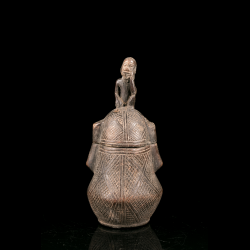










Medicinal vials play a significant role in African art and cultural practices, notably among the Bakongo of the Democratic Republic of Congo (DRC).
Ritual Use: Medicinal vials are often used in healing and protection rituals.
Materials: They can be made of wood, clay, or natural materials, often decorated with significant symbols and motifs.
Content: They typically contain herbs, powders, oils, or sacred mixtures prepared by traditional healers.
Symbolism: Among the Bakongo, these vials, called "nkisi" or "bilongo," are imbued with spiritual powers. They serve to invoke protective spirits or channel healing energies.
Crafting: The vials can be adorned with fabrics, beads, and feathers. They are often sealed with resin to preserve their sacred content.
Use: Used by nganga (healers or priests), they play a central role in healing ceremonies, protection rituals, and divinatory practices.
Medicinal vials are more than utilitarian objects; they are testaments to the richness of African spiritual traditions and beliefs. They illustrate the deep connection between the physical and spiritual worlds in African cultures and their crucial role in the health and well-being of communities.
Data sheet

Medicinal vials play a significant role in African art and cultural practices, notably among the Bakongo of the Democratic Republic of Congo (DRC).
Ritual Use: Medicinal vials are often used in healing and protection rituals.
Materials: They can be made of wood, clay, or natural materials, often decorated with significant symbols and motifs.
Content: They typically contain herbs, powders, oils, or sacred mixtures prepared by traditional healers.
Symbolism: Among the Bakongo, these vials, called "nkisi" or "bilongo," are imbued with spiritual powers. They serve to invoke protective spirits or channel healing energies.
Crafting: The vials can be adorned with fabrics, beads, and feathers. They are often sealed with resin to preserve their sacred content.
Use: Used by nganga (healers or priests), they play a central role in healing ceremonies, protection rituals, and divinatory practices.
Medicinal vials are more than utilitarian objects; they are testaments to the richness of African spiritual traditions and beliefs. They illustrate the deep connection between the physical and spiritual worlds in African cultures and their crucial role in the health and well-being of communities.